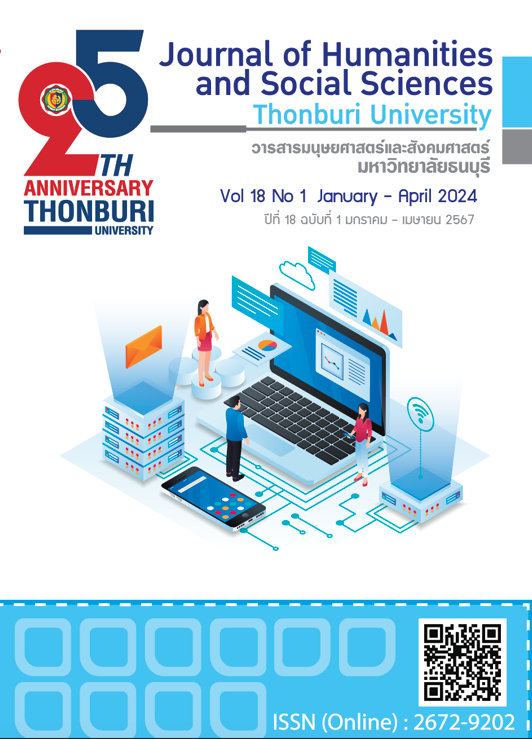กลยุทธ์การจัดการผ้าใยกัญชงอย่างยั่งยืน
คำสำคัญ:
กลยุทธ์การจัดการ, ผ้าใยกัญชง, ยั่งยืนบทคัดย่อ
งานวิจัยนี้มีวัตถุประสงค์เพื่อพัฒนากลยุทธ์การจัดการผ้าใยกัญชงอย่างยั่งยืน ประชากรที่ศึกษาได้แก่ ผู้ตัดเย็บผ้าใยกัญชงในประเทศไทย ทำการสุ่มตัวอย่างแบบเป็นระบบ ได้จำนวนตัวอย่างทั้งหมด 230 คน ใช้เครื่องมือวิจัยเป็นแบบสอบถาม ที่ผ่านการทดสอบความเชื่อมั่น ได้ค่าคอนบรัคอัลฟ่า เท่ากับ 0.958 ใช้สถิติในการวิเคราะห์ข้อมูลด้วยการวิเคราะห์ปัจจัยเชิงยืนยันอันดับสอง ด้วยโปรแกรม SPSS-Amos ทำการวิเคราะห์ปัจจัย 3 ด้าน ได้แก่ ด้านเศรษฐกิจ สังคม และสิ่งแวดล้อม ซึ่งประกอบไปด้วยตัวแปรสังเกตุได้ทั้งหมด 22 ตัวแปร ผลการวิเคราะห์ข้อมูลพบว่าโมเดลมีความสอดคล้องกับข้อมูลเชิงประจักษ์ โดยมีค่า ไคสแควร์ 1.099 p-Value 0.234 df. 99 RMSEA 0.021 ผลการวิจัยพบว่า กลยุทธ์การจัดการผ้าใยกัญชงอย่างยั่งยืนนั้น จะต้องเน้นส่งเสริมปัจจัยทางด้านสังคมเป็นหลัก โดยจะต้องมีการส่งเสริมอาชีพการตัดเย็บที่มั่นคงให้แก่คนในชุมชน สร้างการรับรู้ถึงความสำคัญของมรดกทางวัฒนธรรม นอกจากนี้จะต้องส่งเสริมให้เยาวชนเห็นคุณค่าในการสืบทอดและการอนุรักษ์วัฒนธรรมอย่างยั่งยืน
เอกสารอ้างอิง
กรกนก จรัสหิรัญปรีดา. (2553). กลยุทธ์การจัดการห่วงโซ่คุณค่าของวิสาหกิจเครื่องนุ่งห่มขนาดกลางและขนาดย่อมของไทยเพื่อความสามารถในการแข่งขัน, วารสารวิจัยและพัฒนา, 2(1).
กัลยา วานิชย์บัญชา. (2546). การใช้ SPSS for Window ในการวิเคราะห์ข้อมูล. พิมพ์ครั้งที่ 6. กรุงเทพฯ: บริษัทธรรมสาร.
กาญจนา สุขบัว. (2563). การส่งเสริมภูมิปัญญาการผลิตอาหาร “หม่ำ” ปลอดภัย. วารสารชุมชนวิจัย, มหาวิทยาลัย ราชภัฏ. นครราชสีมา, 14(1).
จำรัส หอมชิด. (2549). ศึกษาอุตสาหกรรมสิ่งทอและเครื่องนุ่งห่มภายใต้กระแสโลกาภิวัตน์. การศึกษาอิสระมหาบัณฑิต มหาวิทยาลัยรามคำแหง.
ฉัตรชัย อินทสังข์ ณพรรณ สินธุศิริม และยุพาภรณ์ ชัยเสนา. (2562). ผลิตภัณฑ์เพื่อสิ่งแวดล้อมและการรับรู้คุณค่าด้านสิ่งแวดล้อมที่มีอิทธิพลต่อความตั้งใจซื้อ. วารสารการจัดการ มหาวิทยาลัยวลัยลักษณ์, 9(3) , 31-41.
ชนากานต์ อุณาพรหม. (2565). พฤติกรรมการซื้อผลิตภัณฑ์ที่เป็นมิตรกับสิ่งแวดล้อมของผู้บริโภคในตำบลโพนงาม อำเภอหนองหาน จังหวัดอุดรธานี. วารสารมหาวิทยาลัยพายัพ, 32(2) , 32-49.
ฑภิพร สุพร. (2554). การพัฒนาและปรับปรุงมาตรฐานด้านสิ่งแวดล้อมใหม่ในตลาดสหภาพยุโรป: กรณีศึกษาการปรับใช้ฉลากสิ่งแวดล้อมต่อสิ่งทอและเครื่องนุ่งห่มของไทย. วารสารอิเล็กทรอนิกส์ มหาวิทยาลัยศิลปากร, 4(2). 273-287.
ดาริกา โพธิรุกข์. (2563). ปัญหาและความสำคัญในการจัดทำข้อบัญญัติท้องถิ่นให้สอดคล้องกับผังเมืองรวม วารสารวิชาการ คณะมนุษยศาสตร์และสังคมศาสตร์มหาวิทยาลัยราชภัฏนครสวรรค์ 6(2), 60-67.
นันทพร ดำรงพงศ์. (2561). ปัจจัยที่ส่งผลต่อความสามารถในการดำเนินธุรกิจของผู้ประกอบการวิสาหกิจขนาดกลางและขนาดย่อมเพื่อรองรับเศรษฐกิจยุคดิจิทัลในประเทศไทย. บัณฑิตวิทยาลัย มหาวิทยาลัยราชภัฏสวนสุนันทา :กรุงเทพฯ. 239-253
นิรันดิ์เกียรติ ลิ่วคุณูปการ. (2564). การจัดการห่วงโซ่คุณค่ากลุ่มวิสาหกิจชุมชนผลิตภัณฑ์เกษตรแปรรูป ในพื้นที่จังหวัดชายแดนใต้, วารสารมหาวิทยาลัยราชภัฏยะลา , 17(1) , 136-146.
ปิยรัตน์ วงศ์จุมมะลิ, รัดเกล้า เปรมประสิทธิ์. (2555). ของเสียเหลือศูนย์ (Zero Waste) : แนวคิดและหลักการสู่สังคมปลอดขยะ, เอกสารประกอบการประชุมวิชาการ (Proceedings) สังคมวิทยาและมานุษยวิทยา, 16(1).
เพ็ญนี ภูมิธรานนท์, นพพร ศรีวรวิไล และวิภารัตน์ จวนรมณีย์ (2558). ความรับผิดชอบต่อสังคมกับคุณภาพชีวิตในการทำงาน. วิทยานิพนธ์บริหารธุรกิจดุษฎีบัณฑิต. มหาวิทยาลัยธุรกิจบัณฑิต.
วรวุฒิ ไชยศร. (2560). ความรับผิดชอบต่อสังคมขององค์กรธุรกิจกับการพัฒนาที่ยั่งยืน:กรณีศึกษาความรับผิดชอบต่อสังคม 6 บริษัท. วารสารปัญญาภิวัฒน์. 9(3), 140-153.
สัจจา บรรจงศิริ. (2558). การจัดการทรัพยากรน้ำโดยชุมชนกรณีศึกษาชุมชนแพรกหนามแดง. วารสารอิเล็กทรอนิกส์การเรียนรู้ทางไกลเชิงนวัตกรรม. 5(1), 120-132.
Barbier, E. (2009). Pricing Nature. Cost-benefit Analysis and Environmental Policy. Cheltenham: Edward Elgar Publishing Limited.
Beamon, B. M. (1998). Supply Chain Design and Analysis: Models and Methods. International Journal of Production Economics, 55, 281-294.
Christopher, M. (1998). Logistics and Supply Chain Management: Strategies for Reducing Cost and Improving Service. Financial Times, London: Prentice-Hall.
Kotler, P. and Keller, K.L. (2012). Marketing Management. 14th Edition, Pearson Education.
Ming-Lang, T., Md, S.,Noorliza, K., Firdaus, F. & Samina, A. (2018). A literature review on green supply chain management: Trends and future challenges Bangladesh: Faculty of Business, ASA University Bangladesh, 145-162.
Muangyai, A. (2016). Development Approach to Enhancing the Potential of Community and Local in the Twenty-First Century. Eau Heritage Journal Social Science and Humanity, 6(3), 12-26.
R., Mongkholrattanasit. (2019). Evaluating the Thermal Conductivity and Q-Max Properties of Quick Dry Inner Wears. In Key Engineering Materials, Trans Tech Publications Ltd, 818(1), 26-30.
Storey, J. (2001). Human Resource Management: A Critical Text. 2nd Edition, Thomson Learning, NewYork.
Translated Thai References
Banjongsirirat, S. (2015). Community-based Water Resource Management: A Case Study of Phraek Nam Daeng Community. Electronic Journal of E-Learning and Innovative Pedagogies, 5(1), 120-132. (in Thai)
Chaisorn, W. (2017). Corporate Social Responsibility and Sustainable Development: A Case Study of Social Responsibility in 6 Companies. Journal of Intellectual Property, 9(3), 140-153. (in Thai)
Dumrongphong, N. (2018). Factors Influencing Entrepreneurial Abilities of Medium and Small-Sized Business Operators to Support the Digital Economy in Thailand. Graduate School, Suan Sunandha Rajabhat University, Bangkok. Pages 239-253. (in Thai)
Homchit, J. (2006). Study of the Textile and Garment Industry under the Globalization Trend. Independent Study, Ramkhamhaeng University. (in Thai)
Inthasang, C., Sintusirim, N., and Chaisena, Y. (2019). Environmental-Friendly Products and Environmental Value Perception Influencing Purchase Intention. Walailak Journal of Management, 9(3), 31-41. (in Thai)
Jarathiranpreda, k. (2010). Strategies for managing the value of Thai garment and small enterprises to stay competitive, Research Journal, 2(1). (in Thai)
Lioukhunupakarn, N. (2021). Managing Value Chain of Community Enterprise Agricultural Product Processing in the Border Area of Southern Thailand. Journal of Yala Rajabhat University, 17(1), 136-146. (in Thai)
Phothiruk, D. (2020). Issues and Importance in Aligning Local Regulations with Urban Planning: Academic Journal of Humanities and Social Sciences, Nakhon Sawan Rajabhat University, 6(2), 60-67. (in Thai)
Pumitharat, P., Sriwarawilai, N. (2015). Social Responsibility and Quality of Life in the Workplace. Master's Thesis in Business Administration, Business Administration Graduate School, Thammasat University. (in Thai)
Sukhbua, K. (2020). Promoting Safe Food Production Knowledge: 'Hom' in Thai. Community Research Journal, Rajabhat University, Nakhon Ratchasima,14(1). (in Thai)
Suphon, T. (2011). Development and Improvement of New Environmental Standards in the European Union Market: A Case Study of Environmental Labeling for Thai Textiles and Garments. Silpakorn University Journal of Social Sciences, Humanities, and Arts, 4(2), 273-287. (in Thai)
Unaphrom, C. (2022). Consumer Purchasing Behavior of Environmentally Friendly Products in Phonnangam Sub-district, Nong Han District, Udon Thani Province. Phayao University Journal, 32(2), 32-49. (in Thai)
Vanichbuncha, K. (2003). Using SPSS for Windows in Data Analysis. 6th Edition. Bangkok: Thammasarn Company. (in Thai)
Wongchummar, P., Premprasit, R. (2012). Zero Waste: Concepts and Principles towards a Waste-Free Society. Proceedings of the Social and Cultural Studies Conference, 16(1). (in Thai)
ดาวน์โหลด
เผยแพร่แล้ว
รูปแบบการอ้างอิง
ฉบับ
ประเภทบทความ
สัญญาอนุญาต
ลิขสิทธิ์ (c) 2023 Wanvachira Juntranut

อนุญาตภายใต้เงื่อนไข Creative Commons Attribution-NonCommercial-NoDerivatives 4.0 International License.
ผลงานที่ปรากฎในวารสารฉบับนี้เป็นลิขสิทธิ์เฉพาะส่วนบุคคลของผู้เขียนซึ่งต้องรับผิดชอบต่อผลทาง กฎหมายที่อาจเกิดขึ้นได้และไม่มีผลต่อกองบรรณาธิการ






